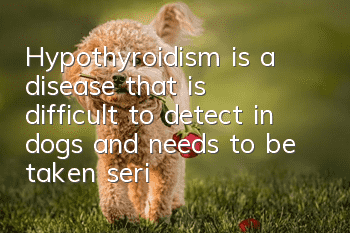Hypothyroidism is a disease that is difficult to detect in dogs and needs to be taken seriously

I often hear about thyroid disease. Do you think that only humans can suffer from this disease? You are wrong. Thyroid is a disease that is not easily found in dogs.
Hypothyroidism is one of the relatively common endocrine diseases in domestic dogs, and it is also one of the diseases that is easily overdiagnosed. The clinical symptoms of canine hypothyroidism are non-specific, and there are no obvious symptoms in the early stages of the disease. Therefore, it is easy for owners or veterinarians to ignore it. It is not until "hypothyroidism crisis" appears that they are taken to the hospital unprepared. However, it is very likely that it will not be possible until later. It's too late.
The thyroid gland is a very important endocrine gland in the dog's body. It is located in the dog's neck and produces thyroid hormone T4 (T4) and other important thyroid hormones. These hormones play an important regulatory role in the dog's metabolism. Once the production of thyroid hormones is at abnormal levels, the dog's physical health will suffer.
One: Hypothyroidism
When dogs do not secrete enough thyroid hormone, a clinical disease characterized by a progressive slowdown in the animal's activity is called hypothyroidism (referred to as hypothyroidism), which is divided into primary, secondary and third types of thyroid disease. All three types of hypofunction will cause the dog’s metabolism to slow down. This condition is more likely to occur in dogs than in other livestock. It is more likely to occur in golden retrievers, Dobermans, Great Danes, German Shepherds, Cocker Spaniels, and Dachshunds. It is more likely to occur in medium and large dogs than in small dogs. There are also reports that hypothyroidism is related to certain vaccines, but so far I have not seen enough evidence to support this statement. An interesting point is that hypothyroidism is often involved in hormonal disorders in domestic dogs. However, when it comes to thyroid cancer in humans, domestic dogs can diagnose thyroid cancer with only their noses to sniff the patient's urine, and their accuracy is as high as 88%. This is different from the fact that domestic dogs can diagnose thyroid cancer in humans. A highly sensitive sense of smell is relevant.
Two: Causes of the disease
In 95% of related cases, destruction of the thyroid gland is the main cause of hypothyroidism. This destruction is often the result of lymphocytic thyroiditis or idiopathic atrophy of the thyroid gland. Other rare causes of hypothyroidism include cancer and congenital defects.
Three: Symptoms
Low thyroid hormone levels can affect all of your dog’s organ systems. But the symptoms of hypothyroidism can vary from dog to dog, but they are all related to a slowed metabolism in dogs.
Here are some common symptoms:
*Drowsiness
*Exercise intolerance
*Sluggish response
*Reduced appetite
*Weight gain
*Afraid of the cold
*Changes in coat and skin, such as hair loss, hyperkeratosis, pigmentation, myxedema, etc.
*Reproductive disorders
Four: Diagnostic methods
"Merck Veterinary Manual" (U.S. Fresa) states that hypothyroidism is one of the most overdiagnosed diseases in domestic dogs. This is because many diseases have similar symptoms to hypothyroidism. Some diseases can even be improved with thyroid medications. Other diseases can affect thyroid levels, but those are not hypothyroidism. This can all make diagnosing thyroid disease tricky.
In addition to the above reasons, there are also certain differences in clinical symptoms among different dog breeds. For example, the main symptom of some dog breeds is hair loss on the trunk, while in other dog breeds, the coat is thinning. This may also affect diagnosis.
The diagnosis of hypothyroidism is a clinical diagnosis. When a veterinarian clinically suspects hypothyroidism in a dog, laboratory results need to be supported or excluded, but the disease must not be diagnosed solely based on laboratory data. The first step is to understand which medications and diseases may affect thyroid function and thyroid lab results. Even without outside influence, laboratory results cannot be completely accurate. Therefore, the diagnosis combined with clinical aspects is particularly significant. Under the above background, the laboratory plan developed will be reasonable and accurate. The usual process is as follows:
* Dogs showing clinical symptoms of hypothyroidism.
*Ask the owner if the dog is taking any medication that affects thyroid function recently. If so, postpone the examination after stopping the medication.
* Exclude euthyroid sick syndrome in dogs through routine biochemical examinations and blood tests
* When it is suitable for thyroid function test, first-line thyroid test - detection of serum total T4 and TSH.
* If the results are unclear, either wait 6 weeks and repeat the same test, or perform a second-line diagnostic test—free T4 with equilibrium dialysis or antithyroglobulin antibody (TgAA) testing.
* If the results are still unclear but hypothyroidism is suspected, diagnostic treatment may be selected.
Once your dog's body becomes abnormal, you need to seek medical treatment promptly. Do not delay to avoid delaying the condition!
- How to treat a pet dog with a bad gastrointestinal condition? Supplement pet probiotics to avoid "glass stomach"!
- How to tell if a dog has ascites
- What to do if a dog bites your shoes
- Tips for raising golden retriever puppies
- What is the best way to disinfect and sterilize dogs? What is the best way to disinfect and sterilize dogs?
- There are many guests during the Chinese New Year. Owners should be careful of these 4 behaviors of dogs. It may bite people.
- What are the precautions for dog training? A must-read for dog owners!
- How to correct a dog biting someone
- Information about dog neutering
- Symptoms of calcium deficiency in dogs



